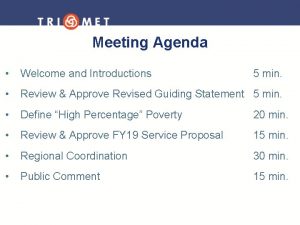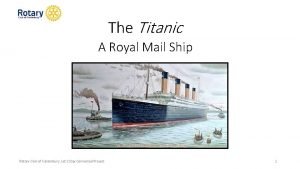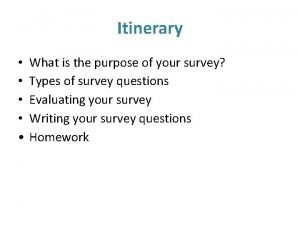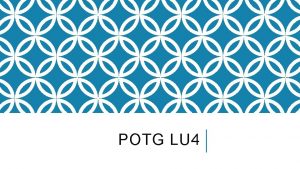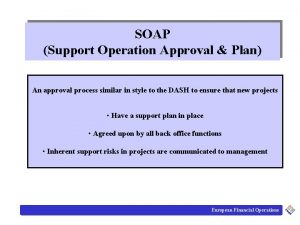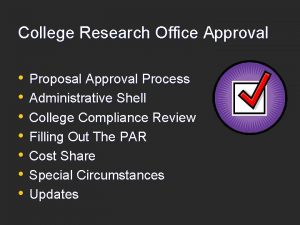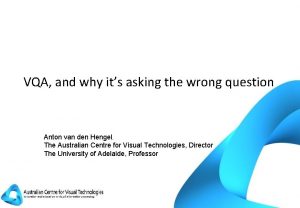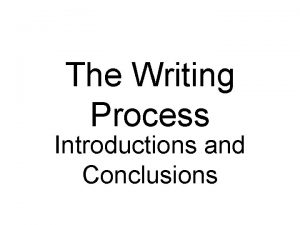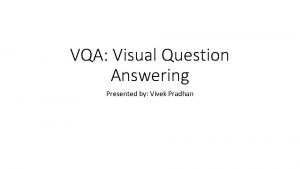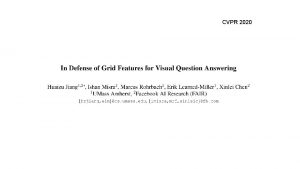VQA TESTING AND APPROVAL PROCESS ITINERARY Welcome Introductions

















- Slides: 17

VQA TESTING AND APPROVAL PROCESS

ITINERARY • Welcome & Introductions • Presentation – 30 mins • Sensory Evaluation Process – 1 hr • Laboratory Tour – 15 mins • Lunch and Final Q&A • Departure

VQA WINE TESTING AND APPROVAL PROCESS Activities: • Applications for wine approvals evaluated: 2, 093 • Number of wines approved for VQA status: 2, 034 • Success rate of 97% Lab analysis • Average time to completion: 12 days • Pass rate at laboratory: 99. 4% (final status) Sensory analysis • Average time to completion: 6 days • Pass rate at sensory panel: 98% (final status) Label Review

WHY IS A TASTING PANEL NEEDED? To protect the reputation of VQA wines, your appellation and to reassure consumers that they are making a good choice in buying a VQA wine. Because certain wine defects are not easily detected in the lab, prior to being approved for sale all VQA wines must also pass a sensory evaluation or tasting to ensure: the wine is free from obvious faults, the wine is representative of quality wines of its general category, the wine is within an acceptable range of varietal character for the stated varieties. Unlike wine critics, the VQA Tasting Panel’s role has nothing to do with whether they like or do not like a wine. The purpose of their evaluation is to screen out faulty wines that are not consistent with the expected characteristics for that product. It is not about wines that are pushing the envelope but wines that are outside of it!

97% SUCCESS RATE The VQA tasting panel does not reject wines that are not typical or avant-garde unless they are faulty. The tasting is done to screen out faulty wines. Only about 3 percent of wines ultimately fail the tasting, with the vast majority of those having sulphide aromas (rotten eggs), oxidation (spoiled fruit) or high volatile acidity (turning to vinegar). Wines do not fail VQA because they are too dry or taste different than a typical Chardonnay. It is true that some experimental wines do not pass but that is because not all experiments are successful. Pushing the envelope is ok until it rips.

SENSORY PANEL COMPOSITION • Qualified Sensory Panelists • Four separate panels with 6 -8 members each • Five panelist results constitute a quorum

PANEL SELECTION CRITERIA AND STANDARDS • Panelists participate in annual training and pass product knowledge testing and sensory evaluation testing • Panelists must demonstrate professionalism and follow a Code of Conduct • Theoretical Examination includes: viticulture, oenology, beverage alcohol manufacturing technologies, general beverage alcohol product knowledge, sensory perceptions, and VQAO regulations • Practical Examination includes: primary taste component identification, sensitivity testing, varietal recognition, wine category, aroma/defects identification, winemaking style and regional character

SCOPE Scope of Sensory Evaluation Testing: • Wines must be of sound quality, representative of the type designation and substantially free of any identified technical faults or defects • Varietal designated wines are assessed for varietal character (the acceptable range is broad – but keep in mind that excessive faults can mask or overcome varietal character) • Proprietary wines are assessed for vinous character • Ex. Sparkling wine with Icewine Dosage, “The finished sparkling wine shall exhibit a distinguishable Icewine character. ”

VQAO TASTING PROCEDURES All samples are evaluated blind. All tastings are conducted in the morning. • Sample ID (#) • Grape variety/varieties • Wine category (table, sparkling, fortified, skin-fermented white wine) • Vintage or NV • Varietal/Proprietary designation (S, D, P) • Method of Production (sparkling only) • Unfiltered (if applicable) • Bottled with Lees (if applicable)

SENSORY EVALUATION METHOD Advantages of a Descriptive System: • Methodology is aligned to other internationally recognized systems • System is designed to evaluate all types of beverage alcohol products (wine, beer, spirits) • Utilizes descriptive indicators to quantify individual attributes, not numeric values • Grading form allows taster’s to focus on the product • Ensures consistency of evaluation results among all panels by eliminating bias

SENSORY EVALUATION METHOD Sensory characteristics applicable to wine include: • Appearance and Colour • Aroma and Bouquet • Taste • Harmony

ELECTRONIC GRADING FORM

PICK LIST

RESULTS • Panelists are required to indicate whether the wine is acceptable based on the standards set out in the VQA rules for the category • The calculated score, summary of votes and comments (for scores <13) are reported to VQAO • A majority vote determines whether the wine is assessed a pass or fail • Initial fails validated with 2 nd bottle tastings, different panel

SYSTEM CONTROLS Grading System Controls: • Security of panellist registration • Ratings cannot be changed once finalized • Sample evaluation cannot be redone • Validation questions are embedded in the grading questionnaire • Calculation validation based on statistical measures • Automated calculation and reporting

RESUBMISSION PROCESS • If a submission fails the tasting: • Resubmission Grading Panel • Appeal Panel

QUESTIONS?
 Devi parikh
Devi parikh Agenda welcome and introductions
Agenda welcome and introductions Agenda welcome and introductions
Agenda welcome and introductions Agenda welcome and introductions
Agenda welcome and introductions Meeting agenda welcome and introductions
Meeting agenda welcome and introductions Agenda welcome and introductions
Agenda welcome and introductions Agenda welcome and introductions
Agenda welcome and introductions Meeting agenda welcome and introductions
Meeting agenda welcome and introductions Agenda welcome and introductions
Agenda welcome and introductions Agenda welcome and introductions
Agenda welcome and introductions Parent orientation agenda
Parent orientation agenda Agenda welcome and introductions
Agenda welcome and introductions Agenda welcome and introductions
Agenda welcome and introductions Titanic rudder
Titanic rudder Unistart deakin
Unistart deakin Mutianyu great wall slide
Mutianyu great wall slide Purpose of an itinerary
Purpose of an itinerary Itinerary team building
Itinerary team building

